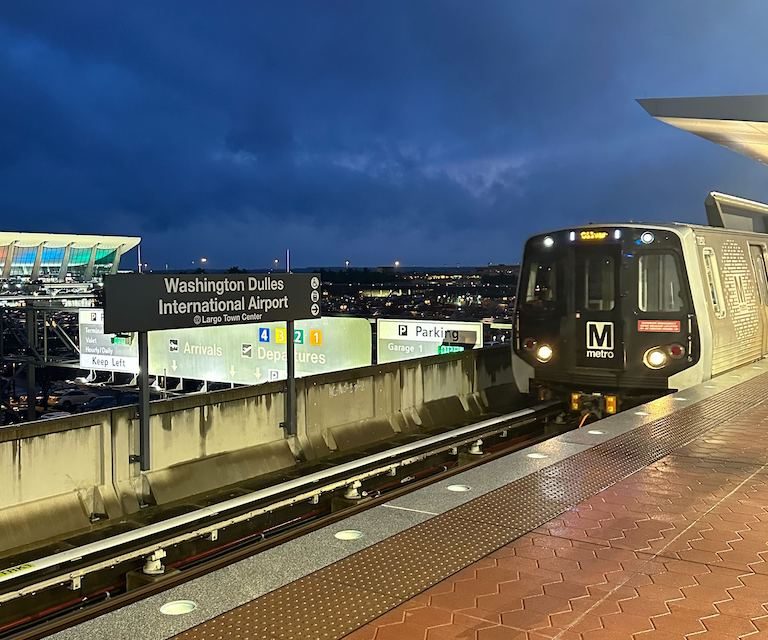By RYAN MERCADO
CHANTILLY, Va. – The Washington Metro Area Transit Authority (WMATA) recently celebrated the first anniversary of the opening of the last Silver Line stations in northern Virginia, despite modest ridership numbers.
“We are thrilled the six new Silver Line stations have had more than 3.4 million trips since we opened last year,” WMATA Media Relations Manager Jordan Pascale told Capital News Service.
The six new stations expanded the Silver Line from the Wiehle–Reston East Station to Washington Dulles International Airport and on to Ashburn in Loudoun County.
Many people have been moving into suburban communities on the new line and have direct access to nearby office complexes, Dulles Airport and downtown Washington.
“We kind of just narrowed it down to one city when we knew where I was going to work,” said 27-year-old Dillon Bull. The systems engineer moved to Reston in March from Washington State with his girlfriend, Johanna Rosenboom, 27, after he accepted a job offer in Chantilly and she took a job as a medical assistant in Fairfax.
“We kind of just saw Reston as kind of an easy, middle point,” Bull said.
Bull and Rosenboom live in Reston. Bull drives to work, but Rosenboom uses the Metro.
According to WMATA’s ridership data portal, the average number of riders passing through the six new stations over the past year was only 794 people per day. That represents a 68% decrease in ridership compared to when the original five Silver Line stations opened in 2014, with a daily ridership of 2,504 passengers per day.
At the Washington Dulles International Airport Station, that number is 1,624 people per day, the busiest of the six new stations.
“It’s actually much less crowded than I would expect, especially since I have colleagues who commute from a similar area and very much don’t use the Metro, ” Rosenboom said. “My daily commute is relatively uneventful. There is always space for me to sit, it’s relatively empty.”
Rosenboom thinks the low numbers have to do with lack of accessibility to the stations.
“Getting from the Metro to my office is not very pedestrian friendly…There’s no signage, there’s no clear path, there’s an area where there’s only one sidewalk on one part of the road,” she said.
Many of the new stations are located in suburban areas where the only way to access them is by driving and parking in a parking garage, an additional daily cost on top of Metro fares.
“I don’t know that the presence of a Metro is really going to have a huge impact on the communities around it when the existing stations are not well integrated to places,” Rosenboom said.
Existing stations on the Silver Line with easy access for pedestrians have the highest ridership.
Of the 11 new stations on the Silver Line opened since 2014, Tysons Station is the busiest, recording 1,728 people per day on average over the past year. The Tysons Corner Center Mall is located at the station and easily accessible to riders.
WMATA, along with other transit systems in the country, is facing low but rebounding riderships this year as people return to offices as the COVID-19 pandemic subsides. Before the pandemic, average daily ridership on the Metro system was 505,903 trips per day. This year, there were only 289,122 trips per day on average, but that was an improvement from a low of 121,000 in 2021.
Despite the low overall ridership on Metro, Dulles Airport has seen positive impacts from the opening of the Silver Line.
“Dulles International Airport has seen more than 1 million trips and airlines have told airport officials they are bringing more flights to IAD because of the direct rail connection,” Pascale said.
According to data from the Metropolitan Washington Airports Authority, air travel at Dulles Airport has completely rebounded since the pandemic, averaging 2,016,316 passengers per month for the past year, from a low of 978,353 passengers per month from 2020 to 2021.
In its first year since opening, the Dulles Metro station has recorded 582,798 total trips, the highest of the six new stations by far.
“It’s super, super convenient for airport access,” Bull said. “That’s my, like, main perk…From my apartment to the airport is like 20 minutes total.” His company sends him on trips about 10 times a year, so having easy airport access to the Metro is an asset.
Reaching Dulles from downtown Washington on the Silver Line takes a little over an hour and costs $6.00 during weekday peak fare prices. By car, the trip takes 50 minutes, not including traffic, tolls, taxis, or rideshare rates and parking.
“Apparently the driving experience to the airport is not super friendly. So having the Metro is incredibly convenient,” Bull said.
While Metro ridership rates are still down, WMATA officials are hopeful for the future.
“As with any new rail line, we expect ridership will increase as economic growth and new travel patterns develop in the area,” Pascale said. “The Silver Line is a generational investment, and we look forward to serving millions of customers in the years to come.”




$3 billion dollars to serve fewer than 1,000 people a day. $3 million per daily rider. What a joke! Our money is being stollen through taxation and then set on fire by an incompetent and corrupt administration. I am sure the government friends and families that got contracts associated with this bonanza loved it though.